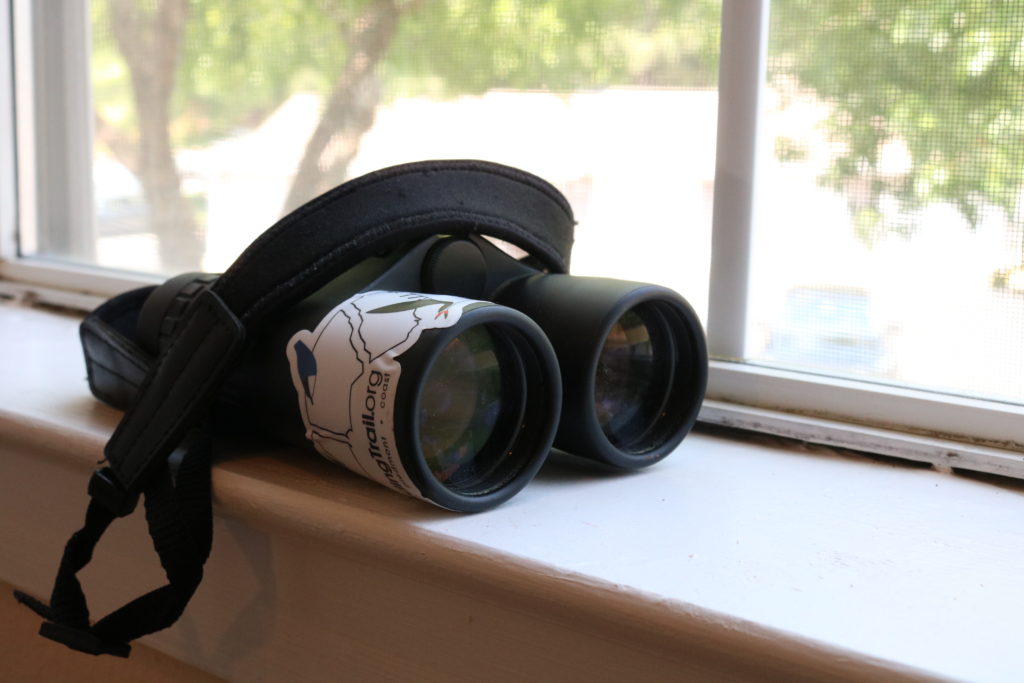
It’s a valid question because it’s a common assumption, one that often creates a birding roadblock: Without binoculars I can’t watch birds. Therefore, if I don’t have binoculars, I cannot attempt bird watching or be a birder.
Similarly, a novice birder or someone who has considered birding, might think that although you can go out and look for birds without aid or peek out your window at your feeder, the experience is going to be diminished without the help of binoculars. How are you going to see anything other than what’s right in front of you? How can you enjoy it if all you can see are some ducks and a couple of bold songbirds?
But are binoculars really necessary? The short answer is actually no, you don’t need binoculars to enjoy watching birds. You may find them useful depending on what you’re looking for, but they are not essential, and there are ways to have a memorable time enjoying birds without binoculars. You will be observing birds with your bare senses, so your experience will simply be different, but still valuable.
Consider some ways you can bird without aid:
One way to do this is to go to a lake where there’s a high chance you’ll see large waterfowl, like ducks, cormorants, herons, and geese. Another option is to seek locations with bold birds. For instance, if you go to a beach, you’ll likely find gulls or sandpipers gladly wandering close to you. Or if you go to a trail, you might find some social robins hopping around in the grass.
Know that you’ll need to maintain enough of a distance to not startle the birds, as this could disrupt their workflow in whatever they’re doing (foraging, looking for nesting material, etc). If you’re looking for guidance on how to respect birds while birding, check out this guide that is–although geared for photographers–valid for all wildlife watchers.
Our favorite way to do this is with native plants, but you can also use bird feeders and bird baths. These allow you to watch a variety of birds from closer up, like from your porch or window. Home habitats can also provide several ways for you to observe and even contribute to conservation with projects like NestWatch.
If you have questions on home habitats, like what are native plants (and which ones are native to NC), how often to replace suet or nectar, or how to collision proof your windows, we have answers!
A lot can be captured from drifting into what is noticeable. Listen for the ebb and flow of bird songs, how they layer into a cacophony and how they respond to one another. See birds soaring overhead, alone or on a chase. Witness one getting close. Catch yourself blending into nature.
This may not fit into what you imagined as a “birding experience,” but if you’re used to—or have only considered—typical birding, this could be a wonderful new experience you may have not been inclined to seek out otherwise.
Now, if you‘re in search of small birds that hang out in high treetops, like warblers and chickadees, you’ll find yourself much more successful with binoculars. Without them you might be able to spot some, but they’ll often be too far away to identify. However, in this environment—say, out on a trail in search for songbirds—consider this happening….
You’re walking on a quiet trail, listening. Songs drawl. You look up to spot a bird flutter from one tree top to another. This alone is peaceful.
The songs are distant, until suddenly, one isn’t. It stands out nearby. With each call, you get closer to it. You’ve narrowed its location down to one of two trees as it calls again. You look to the branches….A male cardinal sings from the vegetation. He’s close enough that you can watch him tilt his head to speak. You notice that the best way to spot him is through a gap in the branches, and you can peek through by kneeling. It’s a success; you’re birding without binoculars.
Although there exists the wonderful chance to get a close look at bird intricacies with visual aid, if a lack of access to binoculars is what’s stopping you from going birding, you should give it a try regardless. Enjoy the experience of watching larger birds, observing birds at feeders, listening for them with your bare senses, and seeing if you can spot them hidden nearby. There’s an added feeling of accomplishment when you can successfully bird without aid.
Now, if you do want to get access to some binoculars, you can start by checking out Audubon’s website and this how to video. They have great options that won’t break the bank. Until then—with or without binoculars—enjoy the wonder that is being in the presence of birds, having higher awareness of birds, and finding many ways to observe these spectacular creatures.